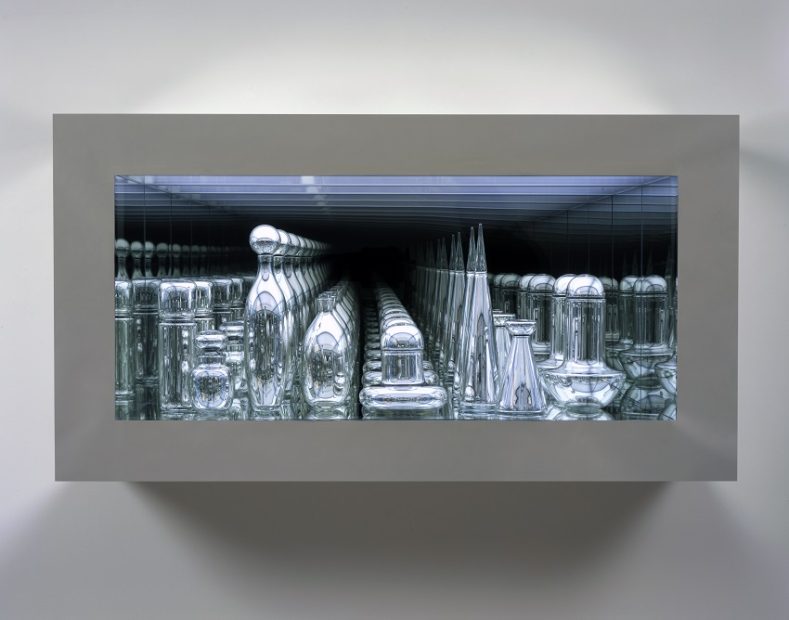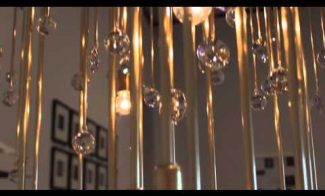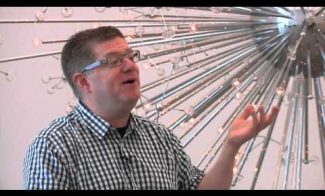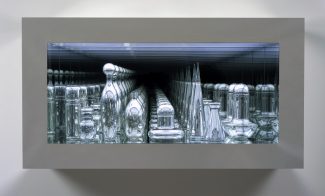Some Pictures of the Infinite tackles cosmic questions, tracing this persistent theme in the work of Josiah McElheny. Over the past two decades, the problem of infinity has driven McElheny’s efforts to represent the unrepresentable, as the infinite by definition must always elude stable grasp. The exhibition also examines images of time: archaeological time, linear and cyclical models, and the overwhelming span of cosmic time.
Trained at both the Rhode Island School of Design and the glass foundries of Europe, McElheny’s highly conceptual projects are realized through exquisitely wrought execution. Though his artistic output varies widely, glassblowing is McElheny’s technique of choice. His impressive command of glassmaking was honed over years of intensive apprenticeship, and his mastery of such skilled labor produces visually arresting works, leveling hierarchies between craft and fine art.
An artist of diverse interests, McElheny draws on art history, politics, and cosmology to encode his works with information, converting beautiful objects into repositories of meaning. Creatively engaging with the history of ideas, McElheny’s work entwines fact, fantasy, and material richness. As the artist has remarked, “we animate objects through our experience of them, our understandings, misunderstandings, memories, and imaginings. Objects are containers, literally and metaphorically.”
In McElheny’s diverse body of work, the infinite crops up again and again: from intricate patterns in glass, such as the dizzying spirals that grace a set of handblown plates, to the endless reflection of mirrored surfaces, as seen in works like Czech Modernism Mirrored and Reflected Infinitely. He has also repeatedly drawn inspiration from the enormity of the cosmos, gaining a working knowledge of astronomy through a long-term collaboration with the cosmologist David Weinberg. Their partnership has resulted in multiple artworks picturing the origins of the universe, with particular attention to the theory of the Big Bang. Through film, prints, and, most spectacularly, a room-sized sculptural installation, McElheny combines iconic mid-century modernist design with scientific theories, extending the ambitions of each.
Some Pictures of the Infinite showcases a new work by McElheny, completed in 2012. Study for The Center Is Everywhere is the latest in a series of works fusing décor and cosmology, formal elegance and conceptual rigor. A suspended sculpture, Study forThe Center Is Everywhere hangs from the ceiling in a glittering column of crystal and brass. The seven-foot-tall sculpture hovers inches off the ground, creating a dynamic relationship between the dangling crystals and the floor below. This enlarged chandelier recalls the turn-of-the-century designs of Josef Hoffmann (1870-1956), whose Vienna Secession light fixtures ground functionality in lushly modernist forms. Hoffmann’s desire to hybridize art, industry, and the artisanal appealed to McElheny, whose sculptures stage that perpetual tension between aesthetic innovation and good design that has beset the avant-garde.
It was Weinberg who suggested the idea for the sculpture, based on the Sloan Digital Sky Survey’s current efforts to chart the whole of the cosmos, one dime-sized portion at time. Powerful telescopes from a New Mexico observatory focus on a specific patch of sky, and physically record the visible objects by perforating holes in a metal plate. One such disc forms the structural basis ofStudy for The Center Is Everywhere, which abstracts and stylizes actual celestial bodies. Streaming downward from the central disc, the sculpture bursts with information, with its hand-cut crystals signifying stars and galaxies, while the brass rods tipped with light bulbs represent distant quasars.
The work’s title comes from the philosopher Blaise Pascal’s centuries-old pronouncement, that “nature is an infinite sphere, whose center is everywhere and whose circumference is nowhere.” Equal parts empirical and aesthetic, McElheny’s imaginative approach to science doesn’t instruct viewers but seduces them, couching cutting-edge cosmology in unabashed formal beauty.




